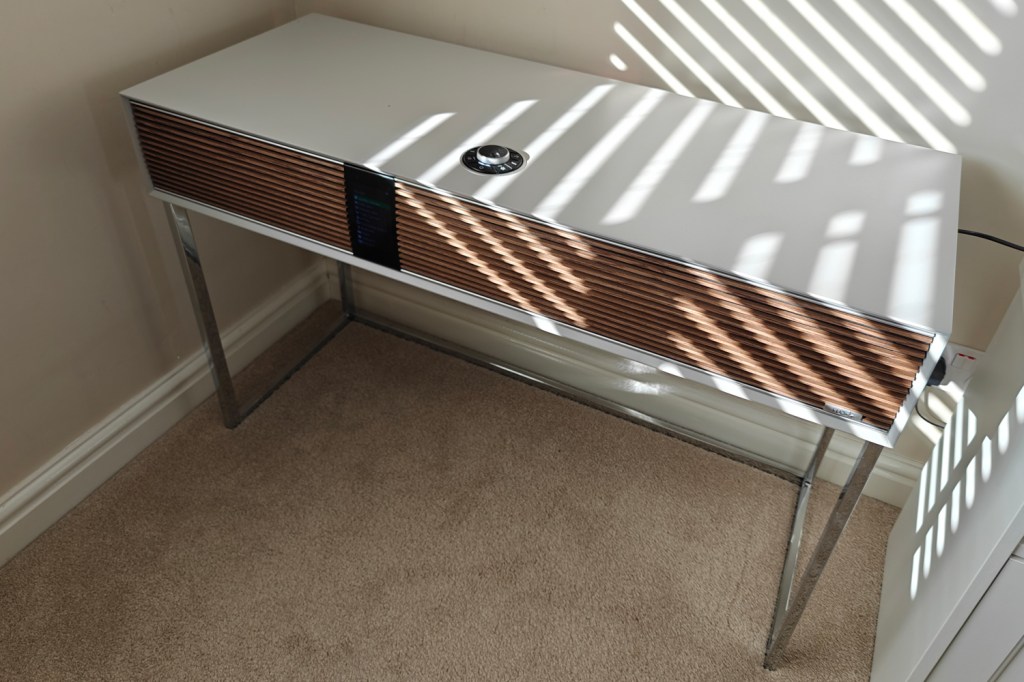Ruark R810 review: audiophile sound, interior design trendsetter
Sound system meets sideboard

Stuff Verdict
A gorgeous, retro-flavoured standalone streaming system that won’t appeal to everyone – but the Ruark R810’s audience will love not having to put style over substance.
Pros
- Design statement funiture that sounds phenomenal
- Effective standalone or as a TV soundbar
- Doesn’t skimp on streaming services
Cons
- Takes up a lot of space – whether floorstanding or on a countertop
- Can’t match a home cinema soundbar for suround sound effects
- A serious financial investment
Introduction
Throwback styling is something of a Ruark hallmark. Most of the British firm’s wireless speakers look like they’ve just stepped out of a time machine from the 1970s – but the R810 also gives a second nod to era’s Hi-Fi trends. This free-standing music system is what would happen if you stripped a classic radiogram of its analogue guts and replaced them with modern digital tech, Robocop-style.
Effectively a bigger brother to the Ruark R410, the R810’s console table-styled appearance lets you hide its potent streaming skills in plain sight – including under your TV in place of a soundbar. That should earn instant appeal with who’s sick of gadgets taking over their home, as well as those who want to simplify a Hi-Fi setup that’s gotten out of control. At least, that’s the theory. At £3000, it’s a sizeable investment for any music fan. Does the R810 sound as good as it looks?
How we test Hi-Fi products
Every speaker, amp and Hi-Fi separate reviewed on Stuff is used for a minimum of a week’s worth of daily listening. We use a playlist of test tracks made up of multiple genres to assess sound, and use our years of experience to compare to other models. Manufacturers have no visibility on reviews before they appear online, and we never accept payment to feature products.
Find out more about how we test and rate products.
Design & build: crowning glory



On its lonesome, the R810 looks like an embiggened R410; both are rectangular cabinets with the sort of scandi-inspired styling that arguably has no business coming from the English south coast. Only this one is considerably larger. It’s almost twice as long and a lot deeper, so you’ll need to free up a lot of space to make room – whether you’ll be using the included stand mount or resting it on an existing bit of furniture.
The subtle silver trim and wooden grille give the impression this is a retro relic, with only the offset LCD display giving away the fact this is a modern bit of kit. My review unit was finished with a Soft Grey chassis and real walnut wood, which gives a consistent grain pattern and won’t change colour over time like artificial veneers will. There’s also a darker option if you’re not sold on the contemporary look.
Both models come with the same polished aluminium frame, which bolts together quickly using the provided hex key and provides a stable base to slot the speaker onto. There’s no way to completely secure the two together, which made me rethink testing the system in my living room (where my infant son is constantly pulling himself up on any available piece of furniture), but accidental bumps aren’t going to dislodge it.
I like how slim the legs are, but wish they added just a little extra height; the system sat a good foot lower than my living room sideboard. You also can’t place it flush to a wall, even if you don’t have any other equipment hooked up, because the power cable juts out slightly. Ruark maybe missed a trick by not adding any sort of cable channelling to the stand. It would look that much neater if the black power cord wasn’t just dangling down from the rear of the system.
Features & connectivity: branching out

The R810 isn’t short on wireless streaming options, with Spotify Connect and Tidal Connect, Apple AirPlay 2, Google Cast, and UPnP playback from a local media server all built-in. You can pick between dual-band Wi-Fi or a wired Ethernet connection to get up and running, and there’s aptX HD Bluetooth for streaming from your portable tech. I said this was a bit behind the times when I reviewed the R410 in 2023, and it remains true here; for the best quality you’ll want to play directly from a supported source like Qobuz or Amazon Music.
FM, DAB+ and internet radio are of course present and correct, too – Ruark hasn’t forgotten what it was best known for over the last few decades.
On the wired side you’ve got stereo RCA, a phono stage for a turntable, digital optical audio, and a USB-C port that can charge your other gadgets. Therre’s also a single HDMI input with eARC, so you can use the system as a TV soundbar.
This was true of the R410, but that smaller unit could look a little lost under even a modestly sized TV. It’s not an issue for the larger R810, and Ruark has also cleverly designed the rear of the unit to fit an optional bracket so you can mount a telly directly to it. The bracket even has a small shelf underneath for holding a media streamer or Blu-ray player. While you don’t get Dolby Atmos or surround sound support, which could be a dealbreaker for cinephiles, it’ll be a night-and-day difference if you’re coming from your TV’s built-in speakers.
Interface: it grows on you



The RotoDial rotary controller built into the top of the R810 and the 4in portrait-oriented LCD screen at its front are carbon copies of the ones seen on the R410. So is the puck-shaped Bluetooth remote control, which charges over USB-C – and still requires pairing with the system by hand, despite being included with the speaker as standard.
Ruark’s rather simple menu system works perfectly well with either controller, and I never missed not having a touchscreen. The brushed metal remote feels every bit as premium as the main unit, with a neat knurled finish on the volume dial that could’ve come straight from a Bentley car. You don’t need line of sight to the system to use it, but get more than a few feet away from the screen and you might struggle to read its small text.
Keep in mind there’s no smartphone companion app here, and if your music library mainly comes from Spotify you’ll need to create favourites on the device itself, unless you want to reach for your phone every time.
Sound quality: wood vibrations



Given it’s that much more megalithic than the R410, the R810 has extra room for speaker drivers. Both systems have a pair of 20mm soft-dome tweeters and 100mm mid-range units at either end of the chassis, but here you’re also getting a beefier 203mm downward-firing woofer to boost the low-end. Two small bass ports complete the 4.1-channel package, which is fed by 180W of class A/B amplification.
Tuning feels very similar to the R410, with a few exceptions. First, I’m not sure I’ve ever heard a single box speaker with as much stereo separation than this – but that shouldn’t come as a shock, given its a full meter wide. It comfortably fills entire rooms with sound, and you don’t need to sit in a sweet spot to get the best from it.
Next, this isn’t as bass-heavy a system as I was expecting given the presence of an extra woofer, and with no subwoofer pre-out there’s no real way to turn it into one, either. That’s not to say songs with lots of low-end lack intensity – Flux Pavilion’s Tick Tock was suitably aggressive in all the right places, without squashing out the rest of the mix.
It’s only when using the R810 as a TV soundbar that you’ll notice any reservations with the bottom end of the frequency range. I missed my usual setup, which has a separate sub. Given Ruark has worked so hard to make this viable as a soundbar everywhere else, it’s odd it would actively remove the subwoofer input here, especially as the R410 had one.
Used primarily for music, though, this speaker still shines. From the mid-range upwards there’s a wonderful level of detail, and not a hint of discordance or harshness from the higher frequencies. Everything sounds convincingly natural and with a great sense of space, which really lends itself to live recordings.
Ruark R810 verdict

Sonically the Ruark R810 is an absolute knockout; it might be a single box system but it has the pipes to rival high-end separates, and doesn’t skimp on ways to play your tunes either. You’re paying a premium for the stellar styling, but that’s true of most Ruark kit.
This is definitely more of a niche system than the everyman R410, though. Simply finding the space for it will be a challenge for some, and some of its sheer presence is lost when using it underneath your TV as a soundbar – even if it performs that role very well, despite not having the surround sound skills required by serious home cinema fans, or support for a subwoofer. While it also makes the same minor UI stumbles as the R410, they aren’t enough to sour the experience.
If you’re sold on the retro look, and have the room to accommodate it, you won’t find any rival that does it quite so convincingly.
Stuff Says…
A gorgeous, retro-flavoured standalone streaming system that won’t appeal to everyone – but its audience will love not having to put style over substance.
Pros
Design statement funiture that sounds phenomenal
Effective standalone or as a TV soundbar
Doesn’t skimp on streaming services
Cons
Takes up a lot of space – whether floorstanding or on a countertop
Can’t match a home cinema soundbar for suround sound effects
A serious financial investment
Ruark R810 technical specifications
| Drivers | 2x 30mm, 2x 100mm, 1x 203mm |
| Amplification | 180W Class A-B |
| Connectivity | HDMI (eARC), Stereo RCA, phono input, digital optical, 1x USB, Ethernet, Wi-Fi |
| Streaming | Internet, DAB+, FM radio, Apple AirPlay, Google Chromecast, Spotify Connect, Tidal Connect, Bluetooth 5.1, DLNA |
| Dimensions | 1000x400x152mm, 27kg (cabinet) 1000x435x650mm, 30.7kg (with stand and mains adapter) |



